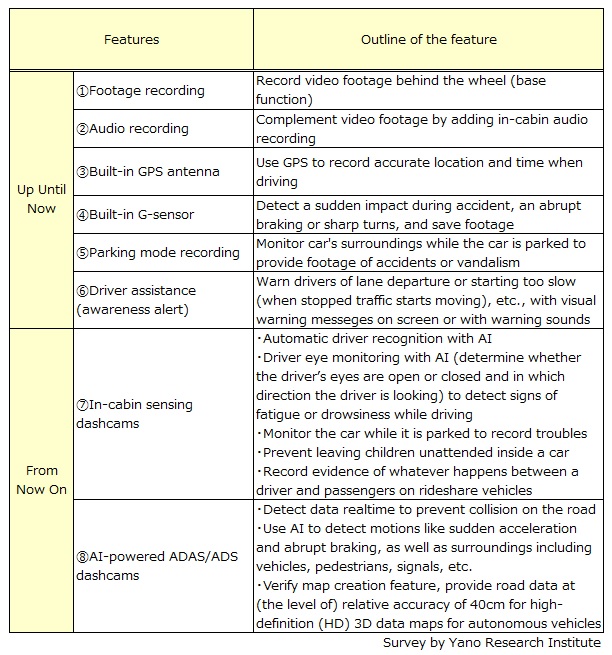No.3495
Automotive In-Cabin Sensing Solutions Market in Japan: Key Research Findings 2024
Dashcams From Now On Will Be Powered by AI and Advanced Sensing Technology - To Be A Standard Automotive Equipment
Yano Research Institute (the President, Takashi Mizukoshi) has conducted a survey on the automotive in-cabin sensing solutions market, and found out the trends by device category, trends of research institutions, and future perspectives. This press release announces the trends of dashboard cameras (dashcams) for passenger cars.


Market Overview
As automobiles that employ ADAS (Advanced Driver Assistance System) or ADS (automated driving systems) penetrate, automotive cameras as "eyes" play a critical role, and thus the number of cameras per vehicle continues to increase. Dashcam suppliers and IT vendors foresee that automakers will equip vehicles with level 4 automation with more than ten cameras.
Currently, dashcams for passenger cars are sold and mounted (as aftermarket products) mostly at auto parts shops or car dealers. In addition to recording video footage behind the wheel, the cameras can record locational information (dashcam with GPS), save footage when an impact is detected, and parking mode recording. It also helps encourage more attentive driving with forward collision warning, alerts for excessive speeding, lane departure warning, and go alert (starting too slow when stopped traffic starts moving). While the current use of dashcam is chiefly for recording footage of accidents or for reducing crime, going forward, it is expected to be integrated with ADAS, as well as to serve as means to provide road environment data for high-definition (HD) 3D data maps (for an autonomous vehicle).
Future Outlook
Going forward, high video resolution will be a regular spec for dashcams, and advanced sensing technology will be built-in. Thereby we believe dashcam will become a standard equipment for vehicles*, instead of being an aftermarket product.
By incorporating AI features, dashcams will be able to serve as an "in-camera" (driver monitoring system) and "out-camera" (front-and-surround view camera). As the driver monitoring system (DMS), the in-cabin sensors monitor drivers and passengers to prevent dangerous driving or detect conditions that may lead to dangerous driving. The front and surrounding camera can record sudden acceleration and sudden start, as well as warn drivers of the surrounding environment.
We forecast that the installation rate of genuine dashcams as standard equipment will be around 1% in Japan by 2030. Dashcams will increase significance as auto equipment as much as other automotive sensors and EDR (event data recorder).
*OEM genuine products
Research Outline
2.Research Object: Businesses related to automotive in-cabin sensing solutions (research institutes, manufacturing retailers, etc.)
3.Research Methogology: Face-to-face interviews by our expert researchers (including online interviews) and literature research
<Products and Services in the Market>
Dashcams (for passenger vehicles, for business use vehicles), smart keys & virtual car keys, alcohol detectors, facial recognition systems, biological signal recognition/electroencephalography & feeling analysis/gesture recognition systems
Published Report
Contact Us
The copyright and all other rights pertaining to this report belong to Yano Research Institute.
Please contact our PR team when quoting the report contents for the purpose other than media coverage.
Depending on the purpose of using our report, we may ask you to present your sentences for confirmation beforehand.